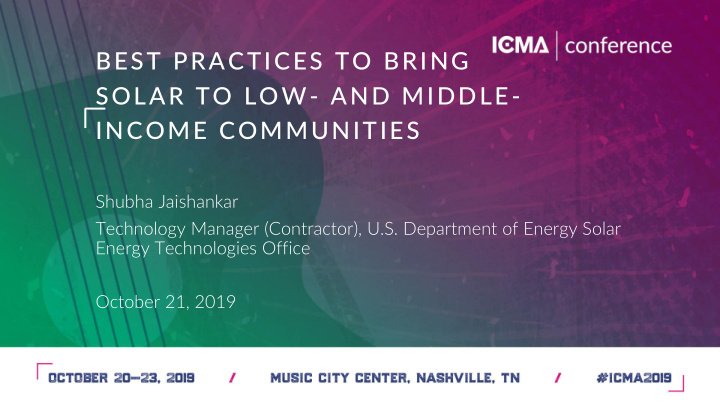



BEST PRACTICES TO BRING SOLAR TO LOW- AND MIDDLE- INCOME COMMUNITIES Shubha Jaishankar Technology Manager (Contractor), U.S. Department of Energy Solar Energy Technologies Office October 21, 2019
SETO + Community Solar, the Early Years 2015 2016 2013 NREL report Funding SETO-led “Shared Solar: Opportunity Workshop Current Landscape, Announcement “Community Market Potential, “Solar Energy Shared Solar: and the Impact of Evolution and Getting to Federal Securities Diffusion Studies 2” Regulation” Scale” 2014 2015 2012 Funding National SETO/NREL Opportunity Community Report Announcement Solar “A Guide to Partnership “Solar Market Community Pathways” Shared Solar” 2
Community Solar Evolution 2019 vs. 2015 Source: Solstice Source: UtilityDive 3
Traditional Rooftop Solar is Limiting of American households and businesses cannot host solar • Bad Roof • Structural constraints • Insufficient roof space • Improper roof orientation • Shading • No Control of Rooftop • Renters • Condos • Left out of solar market • Low credit scores • Can’t make long -term commitment 4
ENTER … THE SOLAR IN YOUR COMMUNITY CHALLENGE!
Overview Goal : engage and support a wide variety of teams developing innovative and scalable business • and financial models that can unlock the low- and moderate-income (LMI), non-profit, and local government solar markets. Contest : design and deploy scalable local solar projects or programs ranging between 25 kW- • 5,000 kW in 18-months that serve min. 20% LMI or 60% non-profits and local governments. Why: to make solar more affordable for market segments where solar is currently too • expensive or not easily accessible. Stats : • • 172 teams selected in 42 states + DC, Guam, and Puerto Rico • 63 teams submitted final prize applications • 13 teams went through external verification of claims • 5 winners selected • 34 teams received seed prizes for reaching milestones • 110 teams received technical assistance through vouchers 6
Winners Best LMI Projects: • Grand Prize ($500,000): CARE Project (Denver, CO) • Runner-Up ($200,000): Community Solar for Community Action (Backus, MN) Best LMI Program ($100,000): Kerrville Area Solar Partners (Kerrville, TX) Best Nonprofit Project ($100,000): Making Energy Work for Rural Oregon (Portland, OR) Best Nonprofit Program ($100,000): Fellowship Energy (Burlingame, CA)
Diverse Business Models in Action 8
National Community Solar Partnership The National Community Solar Partnership is a coalition of community solar stakeholders working to expand access to affordable community solar to every American household by 2025. 2
Goals of the Program ❖ All Americans have a choice and sufficient education to make an informed decision about participation ❖ Overall energy cost burden does not increase as a result of participating in community solar ❖ Communities realize supplementary benefits and other value streams from community solar installations, such as increased resiliency and workforce development 10
Approach ❖ Network Infrastructure: Partners have access to an online community platform, virtual and in-person meetings, webinars and other tools to engage with U.S. Department of Energy (DOE) staff and each other. ❖ Technical Assistance: Partners have access to technical assistance resources from DOE, its National Laboratories, and independent third-party subject-matter experts for support on unique local challenges. ❖ Collaboration: Multi-stakeholder teams of partners form groups around specific goals to address common barriers to solar adoption by learning from each other and sharing resources. 11
Areas of Interest ❖ Inclusive community solar models that enable market adoption in underserved communities ❖ Community solar models that reduce energy bills for multifamily affordable housing dwellers and owners ❖ Utility partnerships around community solar models to expand solar access in their communities 12
Interested in Joining the Network? Visit: energy.gov/community-solar Email: community.solar@ee.doe.gov 13
Recommend
More recommend